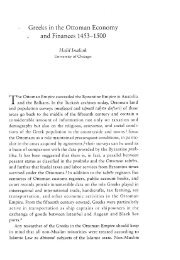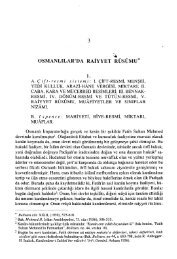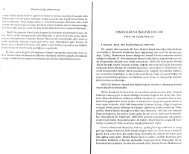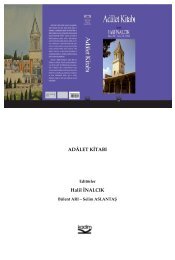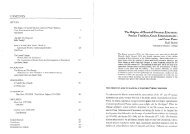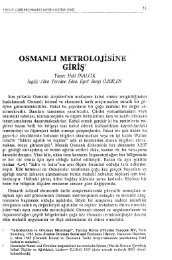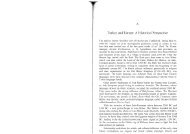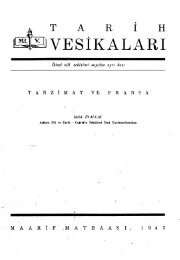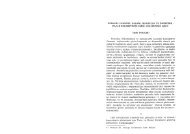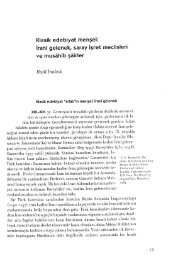Eastern and Western Cultures in Dimitrie Cantemir's Work
Eastern and Western Cultures in Dimitrie Cantemir's Work
Eastern and Western Cultures in Dimitrie Cantemir's Work
You also want an ePaper? Increase the reach of your titles
YUMPU automatically turns print PDFs into web optimized ePapers that Google loves.
Eastem <strong>and</strong> Westem <strong>Cultures</strong> <strong>in</strong> <strong>Dimitrie</strong> <strong>Cantemir's</strong> <strong>Work</strong> = 473<strong>Eastern</strong> <strong>and</strong> <strong>Western</strong> <strong>Cultures</strong> <strong>in</strong> <strong>Dimitrie</strong> <strong>Cantemir's</strong> <strong>Work</strong>I* ,ugn, THE pEAce of Carlowitz that ended a period of unpreced.entedcrisis marked the beg<strong>in</strong>n<strong>in</strong>g of a new era <strong>in</strong> Ottoman history. The Ottomanattitude which had hitherto been condescend<strong>in</strong>g towards the West <strong>and</strong> itsculrure began to give way to a respectful curiosity for that culture <strong>and</strong> itsachievements. This was followed by a desire to have a better underst<strong>and</strong><strong>in</strong>g<strong>and</strong> knowledge of the West <strong>and</strong>, most significantly, to discover thesecret of its success <strong>in</strong> the recent wars. This basic change <strong>in</strong> the Ottomanattitude toward the West was to be the real beg<strong>in</strong>n<strong>in</strong>g <strong>in</strong> Turkey of whatlater came to be known as the process of <strong>Western</strong>ization. On the otherh<strong>and</strong>, <strong>Eastern</strong> mysticism, which allowed for the conception of a unifiedwhole composed of conflict<strong>in</strong>g parts, lifted the barriers berween the twodifferent cultures <strong>and</strong> retgions <strong>and</strong> made it possible for the ref<strong>in</strong>edottoman upper class to approach western culrure sympathetically.In 1703, Rami Mehmed Pasha, Ottoman Secretary who was responsiblefor the conclusion of the treaty of Carlowitz, assumed control of theOttoman government as Gr<strong>and</strong> Yezk. A man of culture <strong>and</strong> an advocateof peace, he adopted peace as the basic pr<strong>in</strong>ciple of Ottoman policy.<strong>Dimitrie</strong> Cantemir (Kantimur),who was then 30 years old, was a closefriend of the new Gr<strong>and</strong> Yezt; <strong>and</strong> he, the Gr<strong>and</strong> Vezir, <strong>and</strong> the latter'spersonal advisor, Nefiyoglu, were the leaders of a new cultural movementwhich later evolved <strong>in</strong>to the Tulip Era. Cantemir described Nefiyoglu asan open-m<strong>in</strong>ded man who by learn<strong>in</strong>g Lat<strong>in</strong> on his own showed a desireto achieve a synthesis of the <strong>Eastern</strong> <strong>and</strong> <strong>Western</strong> cultures <strong>in</strong> his person.A close friend of this select group was the Chief Dragoman Alex<strong>and</strong>erMaurocordatos, who hadplayed an importantpart<strong>in</strong> the conclusion of thepeace of Carlowitz. Maurocordatos was educated at the renowned Universityof Padua, center for exponents of the school of the Greekenlightenment; <strong>and</strong> he was one of those Greeks who <strong>in</strong>troduced the trendof Neo- Aristotelianism <strong>in</strong>to the <strong>in</strong>tellectual life of Istanbul. This trendnotonly dom<strong>in</strong>ated the shap<strong>in</strong>g of <strong>Cantemir's</strong> thought, but it also penetratedOttoman <strong>in</strong>tellecrual life. There was, no doubt, a strong aff<strong>in</strong>itybetween this Neo-Aristotelianism <strong>and</strong> the atheistic trend which theforeign observers of the time witnessed <strong>in</strong> the cosmopolitan-<strong>in</strong>tellectualcircles of the Ottoman capital, at the ko naks of important personages, <strong>and</strong>at Phanar. Lastly, Ahmed II ( 1 69 1- 1 695) <strong>and</strong> later the S ultan of the TulipEra, Ahmed m Q703-I73A), who showed a deep <strong>in</strong>terest <strong>in</strong> Cantemir,were protectors <strong>and</strong> exalted representatives of this milieu.On the other h<strong>and</strong>, these first Ottoman contacts with Europeanhumanism were soon to bear fruit <strong>and</strong> show their <strong>in</strong>fluence on theOttoman way of life, world view, <strong>and</strong> art. In the 18th century the<strong>in</strong>fluence of naturalism <strong>in</strong> Ottoman poetry <strong>and</strong> m<strong>in</strong>iature pa<strong>in</strong>t<strong>in</strong>g aswell as the strong baroque <strong>in</strong>fluence <strong>in</strong> architecture were not merelyco<strong>in</strong>cidental, but they were an outcome of cultural contacts with theWest.Young Beyzdde Cantemir, who had come <strong>in</strong>to close contact with themo st ref<strong>in</strong>ed repre sentatives of the Ea stern culture at the Ottoman p al ac e,played a dom<strong>in</strong>antrole <strong>in</strong> the meet<strong>in</strong>g of the <strong>Eastern</strong> <strong>and</strong>Westem cultures.He had come to Istanbul <strong>in</strong> 1688 at the age of 15 <strong>and</strong> spent twenty-twoyears of his life totally immersed <strong>in</strong> the <strong>in</strong>tellectual life of both the East<strong>and</strong> the West as these were rep esented <strong>in</strong> the Ottoman capital. In hispalace at Fethiye (Ulah Sarayi) the f<strong>in</strong>est <strong>in</strong>tellectual <strong>and</strong> artistic expressionsof the wo cultures were reconciled with<strong>in</strong> a decor of Ottomanpomp, while <strong>in</strong> his mansion at Ortakdy Turkish music composed byCantemir echoed on the waters of the Bosphoms. A disciple of AhmedQelebi of Edirne, Cantemir notated Ottoman music for the first time,thereby secur<strong>in</strong>g for himself an undisputed position <strong>in</strong> the history ofTurkish music. In short, Cantemir was a product of the cultural <strong>and</strong><strong>in</strong>tellectual life of Istanbul as much as he was one of those who gavedirection to the new cultural orientation <strong>in</strong> the Ottoman capital.In the period follow<strong>in</strong>g the peace of Carlowitz, Ottomans hadalready accepted the reality of the decl<strong>in</strong>e of their empire, <strong>and</strong> thequestion of decl<strong>in</strong>e was a subject of heated discussion <strong>in</strong> the <strong>in</strong>tellectualcircles of Istanbul. Cantemir was follow<strong>in</strong>g this trend when laterhe devoted a large part of his work to this question <strong>and</strong> titled his rnajorwork on Ottoman history Incrementa atque decrementa aulaeothomanicae (History of the Growth <strong>and</strong> Decay of the OttomanEmpire). He also wrote a treatise on the topic of the rise <strong>and</strong> decl<strong>in</strong>eof empires. The anthropomorphic view of state that dom<strong>in</strong>atedCantimir's works had been applied to Ottoman history s<strong>in</strong>ce the tirneof Hadji Khalifa ( 1608- 1657). Accord<strong>in</strong>g to Hadji Khalifa, war couldhave fatal results for empires which hadreached "old age." Therefore,empires should avoid wars at this stage of their development. This
"i:,.'!&414 = Halil Inalctkconcept had formed the basis of Rami Mehmed Pasha's <strong>and</strong> hisfollowers' peace policy.F<strong>in</strong>ally, Cantemir was as much an admirer of European culture (ofwhose historical <strong>and</strong> philosophical roots he had a remarkable grasp)as he was an excellent connoisseur of Ottoman cultural life. In 17I0,when he became the voivode of his homel<strong>and</strong>, Moldavia, ascend<strong>in</strong>gthe throne of his father, Constant<strong>in</strong> Cantemir, he dreamt of mak<strong>in</strong>g hispr<strong>in</strong>cipality <strong>in</strong>dependent of the Ottoman Empire. In order to realizethis vision <strong>and</strong> anticipat<strong>in</strong>g a Russian victory over the Ottomans, heentered <strong>in</strong>to a secret agreement with Tsar Peter the Great of Russiaaga<strong>in</strong>st the Ottomans. His calculations, however, backfired whenPeter was defeated by the Ottomans. Follow<strong>in</strong>g the treaty of Prut(I711) Cantemir settled <strong>in</strong> Russia as counselor to Peter <strong>and</strong> directedhis <strong>in</strong>tellectual endeavors to a systemic expression of the knowledge<strong>and</strong> ideas which he had acquired <strong>in</strong> the Ottoman Empire. It was dur<strong>in</strong>gthis period, when he felt a deep nostalgia for Istanbul <strong>and</strong> his life therethat he wrote his history of the Ottoman Empire (I7l4-I1t6) <strong>and</strong> awork on Islam <strong>and</strong> its <strong>in</strong>stitutions (Curanus, 1'119). Until the appearanceof J. von Hammer's history, <strong>Cantemir's</strong> work on the OttomanEmpire was regarded <strong>in</strong> Europe as the st<strong>and</strong>ard work on the subject.At the present time, his first-h<strong>and</strong> descriptions <strong>and</strong> accounts ofOttoman life <strong>and</strong> <strong>in</strong>stitutions , of which he had an <strong>in</strong>timate knowledge,still rema<strong>in</strong> <strong>in</strong>valuable. However, the translations of his Ottomanhistory available <strong>in</strong> <strong>Western</strong> languages are seriously h<strong>and</strong>icapped byspell<strong>in</strong>g errors. Consequently, a ffanslation from its Lat<strong>in</strong> orig<strong>in</strong>al ofthose parts of <strong>Cantemir's</strong> work which deal with Ottoman <strong>in</strong>stitutionsas well as a compilation <strong>and</strong> translation of those passages rn Cttrantts,which conta<strong>in</strong> <strong>in</strong>valuable <strong>in</strong>formation on Ottoman religious life <strong>and</strong><strong>in</strong>stitutions, will def<strong>in</strong>itely fulfill a scholarly need.In sum, <strong>Cantemir's</strong> genius <strong>in</strong> the first stage of his life was a vehiclethrough which the various facets of <strong>Western</strong> culture <strong>in</strong>filtrated Ottomansociety, while <strong>in</strong> the latter part of his life he presented Ottomanculture, which he <strong>in</strong>timately knew <strong>and</strong> loved, to Europe. There is nodoubt that <strong>Dimitrie</strong> Cantemir, the father of Romanian humanism <strong>and</strong><strong>in</strong>tellectual revival, was one of those rare geniuses who showed aremarkable comprehension of <strong>Eastern</strong> <strong>and</strong> <strong>Western</strong> cultures of histime, <strong>and</strong> expressed them <strong>in</strong> a masterly fashion.Panr VMISCELLANIA_11...:i
Indiana University Tirrkish Srudies <strong>and</strong>Tirrkish M<strong>in</strong>istry of Culture Jo<strong>in</strong>t SeriesGeneral Editor: Ilhrn BaggozHalil InalcrkTheMiddle East<strong>and</strong> theBalkansunder theOttoman EmpireEssays on Economy <strong>and</strong> SocietyIndiana Universi$ Turkish Studies <strong>and</strong>Turkish M<strong>in</strong>istry of Culture Jo<strong>in</strong>t SeriesVolume 9oBrooMtNGToNBlllrent UnlversifyHalil lnalcrk Center




